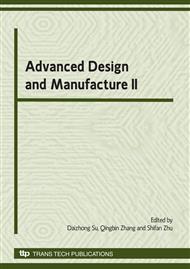p.245
p.249
p.253
p.257
p.261
p.265
p.269
p.273
p.277
Design and Analysis of a Cylindrical Traveling Wave Ultrasonic Motor Using Orthogonal Longitudinal Composite Transducer
Abstract:
A cylindrical type traveling wave ultrasonic motor using orthogonal longitudinal composite transducer is proposed. The composite transducer contains two longitudinal transducers, which are located orthogonal to each other. Each longitudinal transducer includes one exponential horn located on leading end, and the horns insect with each other at tip ends. The composite transducer is attached to the cylinder on its outer surface to excite two degenerate flexural vibration modes spatially and temporally orthogonal to each other in the cylinder. Thus, a flexural traveling wave in the cylinder could be excited. The working principle of proposed motor is analyzed. The stator is designed with FEM. The vibration modals of stator are degenerated. Transient analysis is developed to gain the vibration characteristics of stator, and results indicate that the motion trajectories of nodes on the teeth are ellipses. The results of this paper verify the theoretical feasibility and provide instructions for the development of proposed motor.
Info:
Periodical:
Pages:
261-264
Citation:
Online since:
October 2009
Authors:
Price:
Сopyright:
© 2010 Trans Tech Publications Ltd. All Rights Reserved
Share:
Citation:


